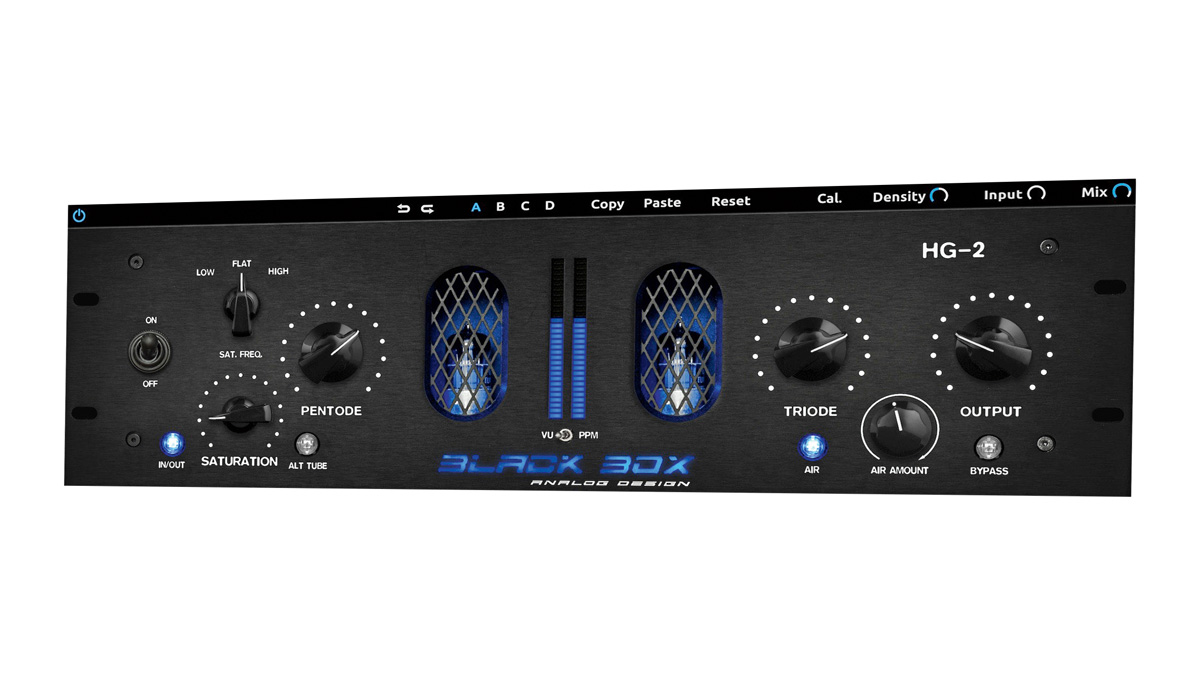MusicRadar Verdict
We simply can’t fault Brainworx’ fabulous virtualisation of BBAD’s much-loved mastering and mixing monster.
Pros
- +
Pentode and Triode tube models.
- +
Parallel saturation with two AX7 models.
- +
Air provides gorgeous lift .
- +
Sounds stunning on busses and tracks.
Cons
- -
Gain staging is odd at first.
MusicRadar's got your back
Developed by Brainworx, the official plugin emulation of Black Box Analog Design’s gorgeous $3000 chunk of boutique hardware valve distortion is built with mastering applications in mind, but is also applicable to group busses and even single instrument and vocal channels in need of harmonic sweetening, roughing up or anything in between.
Along with modelled input and output transformers, four tubes are emulated within HG-2’s (VST/AU/AAX) architecture: serial 6U8A Pentode and Triode models, and a choice of two 12AX7s in a parallel saturation circuit, switched between with the Alt Tube button.
As in the real world, the Pentode tube generates even harmonics for ‘musical’ distortion of the guitar amp kind, while Triode is all about the edgier third order harmonics that come from pushing a signal hard onto tape. Of the two AX7s, meanwhile, Alt-in is the more aggressive.
Outside the box
With three separate gain and distortion stages to consider and balance, using HG-2 should be pretty confusing, but it’s actually surprisingly intuitive.
The input signal hits the Pentode tube first, where it’s mixed with the output of the Saturation tube, before the sum is sent through the Triode tube, with its harsher distortion, then brought back up or down with the Output control.
The knobs set the input gain for each tube, so if either the Pentode or Triode are set fully anticlockwise, the end result is silence at the output, as the two are arranged in series. With Saturation being a parallel circuit that feeds into Pentode, though, zeroing that one just stops it having any effect.
The Saturation stage operates in the broadband Flat mode by default, but switching it to Low or High focuses it on the low/low-mid or high/high-mid frequency ranges.
The tiny bipolar Density knob in the top bar overdrives or attenuates the Pentode and Triode tubes with compensatory output gain adjustment, for thickening up or thinning out the sound. Further gain modification is on hand via the neighbouring Input Gain dial, giving up to 12dB of boost or attenuation at the very front of the plugin. You won’t find either of these - or the wet/dry Mix knob - on the hardware HG-2.
HG's swell
Just like its hardware equivalent, HG-2 is one of those brilliantly designed and calibrated processors with which finding the sweet spot for your mix or bus is never a chore; and it delivers absolutely superb results every time.
The hardware HG-2 concludes its signal flow with the Air circuit - a 10kHz shelving boost for adding high-end sheen and, well, air, activated by a button on the front panel. The plugin version has the same button, of course, but also brings the internal trim control out into the open, enabling easy adjustment of the amount of boost applied.
Completely exclusive to the software HG-2, however, is the Calibrate menu, offering three settings: Dark, Normal and Bright. The choice made here (Normal being the default) affects the high frequency response of the whole plugin, with Dark tilting things towards the low end and Bright emphasising the highs. The differences between them aren’t anywhere near as profound as the variations brought into play by the three Saturation modes, but Dark and Bright are certainly useful options to have when dealing with mixes and sounds that just need a little push in either direction.
The Pentode tube works in such sweet harmonic enhancement that you’ll want to use it on everything, while cranking the Triode takes things into harsher textural territory. The Low and High Saturation modes prove very effective for plumping up weedy mixes or adding shine to overly dull ones, while the Air circuit (see Curved Air) shelves the top end nicely.
The range of sonic colours that can be coaxed from this tubular triumvirate is truly impressive, as are its overall loudness-boosting effect.
It’s not exactly a pocket money buy, that’s for sure, but HG-2 is much cheaper than its real- world counterpart, and stands as a formidable mixing and mastering tool for serious producers, who are sure fall in love with its beefy ‘analogue’ sound, remarkable versatility and original processing paradigm.
Computer Music magazine is the world’s best selling publication dedicated solely to making great music with your Mac or PC computer. Each issue it brings its lucky readers the best in cutting-edge tutorials, need-to-know, expert software reviews and even all the tools you actually need to make great music today, courtesy of our legendary CM Plugin Suite.
With its latest free update, Ableton has finally turned Note into the app I always wanted it to be
Technically capable, but struggle to make your tunes sound musical? 5 simple music theory hacks to make your tracks stand out
"Despite its size, it delivers impressive audio quality and premium functions as well as featuring a good selection of inspired sounds": Roland GO:Piano 88PX review











